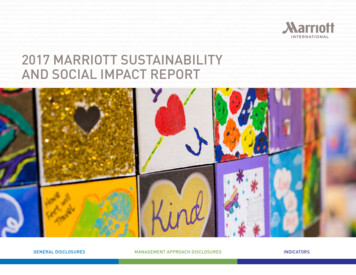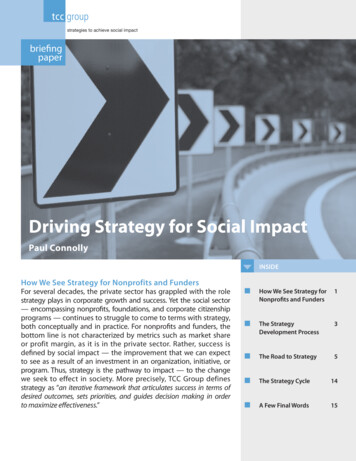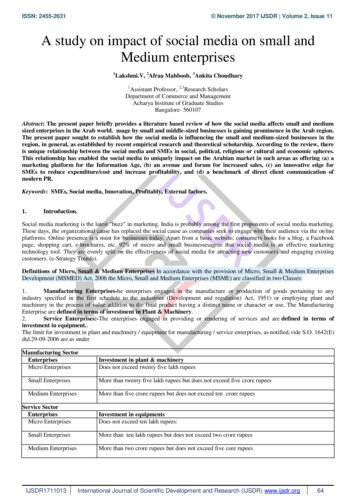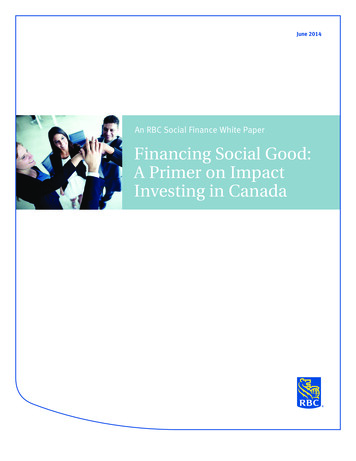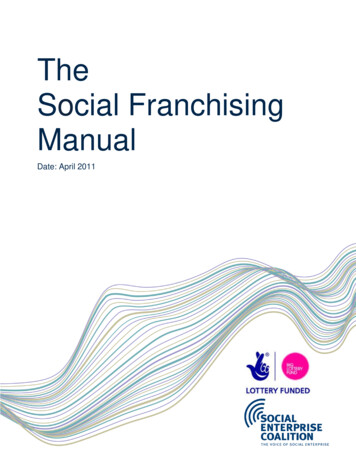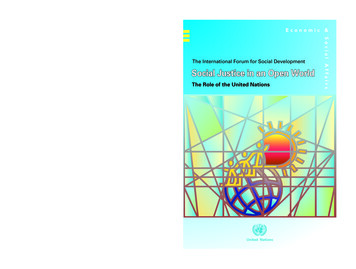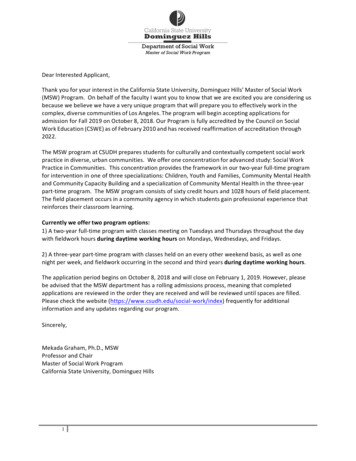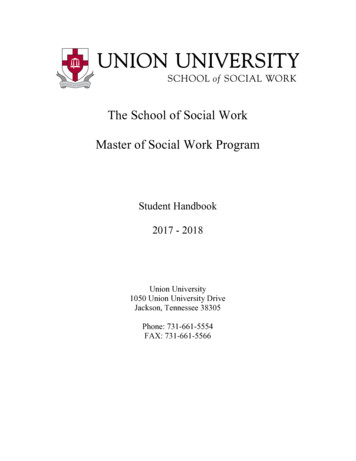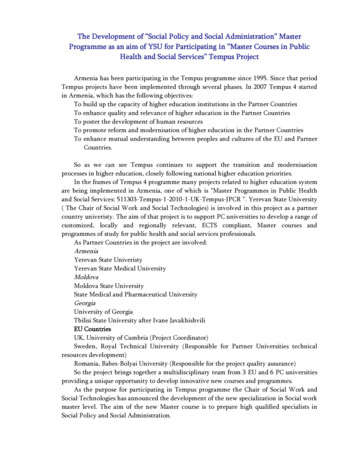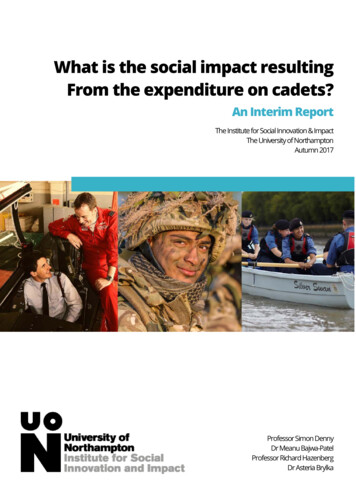
Transcription
What is the social impact resultingFrom the expenditure on cadets?An Interim ReportThe Institute for Social Innovation & ImpactThe University of NorthamptonAutumn 2017Professor Simon DennyDr Meanu Bajwa-PatelProfessor Richard HazenbergDr Asteria Brylka
ISII & University of NorthamptonContents1. Glossary22. Acknowledgements33. Executive Summary44. Introduction54.1 Social Impact4.2 Research Methods665. Results75.1 Themes5.1.1 Communication, confidence& leadership5.1.2 Social mobility5.1.3 Inclusive communities5.1.4 CFAVs5.1.5 Careers/Employability6. Conclusions778141819216.1 Recommendations6.1.1 Limitations23247. References251
Social impact resulting from the expenditure on cadets1. GlossaryACFArmy Cadet ForceASDAutistic Spectrum DisorderBAMEBlack, Asian, minority ethnicBTECBusiness and Technology Education Council (Qualification)CCFCombined Cadet ForceCCFACombined Cadet Force AssociationCEPCadet Expansion ProgrammeCFAVSCadet Force Adult VolunteersCVCurriculum VitaeCVQOEducation charity, providing vocational qualifications to youth groupmembers and adult volunteersDBEDame Commander of the Order of the British EmpireDfEDepartment for EducationFSMFree School MealsGMACFGreater Manchester Army Cadet ForceHMRCHer Majesty’s Revenue and CustomsILMInstitute of Leadership and ManagementISIIInstitute for Social Innovation and ImpactMODMinistry of DefenceNEETNot in employment, education or training (young person)NHSNational Health ServiceONSOffice for National StatisticsPREVENTPart of the Government’s counter terrorism campaignRAFRoyal Air ForceSENDSpecial educational needs and disabilitySNCOSenior non-commissioned officerSTEMScience, technology, engineering and mathsUKUnited Kingdom2
ISII & University of Northampton2. AcknowledgmentsIt would not have been possible to produce this interim report in such a short time period withoutthe willing help of Cadet Forces Adult Volunteers, Cadets and their parents/carers, and servingpersonnel in all branches of the Armed Forces. The research team is particularly grateful to thefollowing individuals and units that wend above and beyond the call of duty to help the researchteam meet the deadline for this interim report:Cadet UnitsGreater Manchester, ACF, especially Col M Glover, Col P Irvine, Lt Col G Potts, and T CornmellSussex ACF, especially Col D SteeleArmyHeadquarters team the Royal Regiment of FusiliersLt Col J Lamb MC, CO 1 RRFMaj Gen R Stanford MBE GOC Support CommandSea CadetsJ Parker-Jones, Director of Business Management MSSCRoyal Air ForceRAF Cranwell and Air Cadets teamSchoolsBlessed John Henry Newman RC College, OldhamManchester AcademyFinally, we thank the personnel of the Cadet team in the MOD for their assistance in helping theresearch team gain access to data and personnel.3
Social impact resulting from the expenditure on cadets3. Executive summaryThe financial value of every aspect of social impact delivered by the four MOD-sponsored CadetForces 1 is not possible to quantify exactly (future reports will improve the reporting of financialbenefit). However, the evidence gathered for this interim report clearly demonstrates that thevalue of the social impact that Cadet Forces deliver is vastly greater than the annual cost of theCadet Forces to the Defence budget. These benefits go across Government departments and areclearly relevant to Defence, Education, Social Services, HMRC and the Cabinet Office. Cadet Forcesdeliver impact that is directly relevant to the Prime Minister’s vision of a “shared society” andclearly contribute to increasing social mobility and decreasing social disadvantage. Specifically, theresearch to date has identified that:1 Cadet Forces are effective at supporting children that receive Free School Meals(FSM) to achieve their potential. The potential saving to the UK that the Cadet Forcesmake by supporting, encouraging and developing current cadets that are FSM children, isgreater than twice the amount which MOD spends annually on cadets. A study carried out in Greater Manchester strongly indicates that children that have beenexcluded from school and who join cadets are statistically significantly more likely tohave improved attendance and behaviour on their return to education. The savings tothe education budget of these social impacts are potentially huge. The Cadet Forces have a significant impact on making communities more inclusive. It isclear that cadet detachments enable people to overcome disadvantages in a way thatschools do not. For most people, Sea, Army and Air Cadets are the visible face of the Armed Forces in theCommunity. The activities that cadets and Cadet Force Adult Volunteers (CFAVs) carry outas they deliver military values, results in increased recognition and awareness of ourArmed Forces and improved respect for veterans. The formal training provided by all Cadet Forces is highly regarded. There is a very strongbelief that CVQO courses have great value for CFAVs. They are deemed particularly usefulfor those adult volunteers with few or no qualifications. The qualifications and awards thatadult volunteers have gained are estimated as providing the current adult volunteers withpotential lifetime earnings increase of 15.58 million 2 Many adult volunteers gain significant personal and social benefits from beinginvolved with cadets.The Sea Cadet Corps, the Combined Cadet Force, the Army Cadet Force; and the Air Training Corps.2This is based upon an analysis of 338 CFAVs who gained accredited qualifications of NVQ Level 2 or higher. This does not include theother 186,000 qualifications gained since 1965. See Section 4.4 in the Methodology Paper for more information.4
ISII & University of Northampton Serving soldiers that were cadets have: higher self-efficacy 3; are four times more likelyto be a SNCO or officer than non-cadets; and serve at least six years longer onaverage than non- cadets. Furthermore, 94% of serving soldiers that were cadets said ithad ‘positively’ helped their Army career, and 25% of them stated that being a cadet hadbeen “very useful” to their career. Moreover, serving soldiers that were cadets reportedthat the main personality traits that had been developed by their experiences in the ArmyCadet Force (ACF) or Combined Cadet Force (CCF) were leadership and self-discipline. The development of communication, confidence and leadership skills that all fourCadet Forces deliver, are valued by cadets, parents, educational organisations, andemployers. This skills development underpins all of the social impact that the Cadet Forcesdeliver.4. IntroductionIn July 2016, on behalf of the MOD, the Combined Cadet Force Association and CVQOcommissioned the Institute for Social Innovation and Impact (ISII) at the University ofNorthampton to undertake a four-year longitudinal research project. The project is designed tohelp understand the social impact of the spending on cadets and the Cadet ExpansionProgramme (CEP), as well as the benefits of the qualifications provided by CVQO, (Appendix 1.1research questions).This is an interim report produced by the ISII research team. It is based on partial data andcontains preliminary findings on the social impact of expenditure on cadets.Cadet Force programmes have multifaceted aims, as shown in Figure 1.CoherenceInnovationValue forMoney Provide interesting & challenging activities and develop life skills in young people Develop a volunteering ethos and an interest in healthy lifestyles/physical activities Encourage young people, from a range of cultures and backgrounds, to take interest inDefence and the Armed Forces Ensure public awareness and support for the Armed ForcesFigure 1 –Diagramshowing theaims of theCadet Forceprogrammes To contribute to British society & business by developing wider skills (in a range ofqualifications and areas such as leadership and teamwork) and citizenship in youngpeople and CFAVs3Self-efficacy reflects a person’s confidence in their ability to exert control over their own future, including motivation, behaviour andtheir social environment. An individual’s perception of their self-efficacy affects the nature of the activities that they take part in, howmuch effort they put into them and how long they will persevere in these activities when faced with adversity. Self-efficacy provides thecritical link between an individual possessing certain skills or abilities, and their actual engagement in an activity that requires thoseskills (Bandura, 1997).5
Social impact resulting from the expenditure on cadetsSome of these aims directly benefit the Armed Forces and MOD, for example through raisingcadets’ awareness of military careers. Other aims e.g. developing life skills such as first aid, benefitsociety as a whole and thus, of course, other Government departments.4.1 Social ImpactThere is no universally accepted definition of what social impact constitutes. The brief agreed withthe project Commissioners is, “using Government data and figures, and data gathered throughoriginal research, the project will measure and report on the economic and social benefitsdelivered by the Cadet Forces to individuals and society”. It is these terms of reference thatunderpin the work that has been conducted thus far into measuring the social impact of cadets.4.2 Research MethodsThe data for this interim report on the social impact of the Cadet Forces has been gathered fromSea Cadets, ACF, and Air Training Corps (ATC) cadets, ACF CFAVs, parents, teachers and servingArmed Forces personnel, using a range of robust and rigorous research methods. To allow theresearch team to gather a wide range of data many cadet units and military personnel madethemselves or data available at short notice. For this report, ATC cadets have provided much ofthe data gathered through questionnaires, while cadets and CFAVs from ACF units have providedmuch of the data gathered through interviews.Primary data was collected via 136 semi-structured interviews, mainly face-to-face, with cadets,CFAVs, senior officers and parents/carers, and school staff between August 2016 and July 2017.Primary data has also come from online surveys, measuring the general self-efficacy of cadets(1648 respondents) and another with serving soldiers (280 respondents). Additionally, 104 CFAVscompleted questionnaires between January and March 2017. Secondary data has been gatheredthrough analysis of selected Westminster data (a cadet Management Information System) andMOD statistics, a range of Government websites, and a study of previous reports and literature(Plastow, Beckett, Sharwood-Smith, Moon, see References).Using such a range of data allows for the breadth and depth of the social impact to be identified,however, this is an interim report which is part of a longitudinal four-year study, so inevitablythese findings are not definitive. Further research will explore these initial findings in more depthand allow for more longitudinal and substantiated conclusions to be drawn. Participants werepromised confidentiality and results have been made anonymous as necessary to ensure this. Amore detailed account of research methods employed by the research team can be found atAppendix 1.2. A paper focused on the methodology adopted with specific reference to socialimpact measurement has also been produced by the research team and is available on request.6
ISII & University of Northampton5. Results5.1 ThemesThe primary and secondary data gathered was analysed and the areas of social impact identifiedwere categorised into four main themes:1.2.3.4.Social MobilityInclusive CommunitiesCFAVsCareers/Employabilitya. Civilianb. Military (Regular/Reserves recruitment/retention)The qualitative findings were analysed using data-driven coding, which is where the codes derivefrom the raw data. The research team used Tesch’s (1990) eight-step model and agreed on 120codes which were then grouped into a number of themes and utilised as part of the interimreport. A more detailed breakdown of the themes is shown in Figure 2 below, and each theme isexamined in turn in the report. In order to keep this report relatively concise, the key findingsunder each theme have been summarised, with further details being supplied in a separatedocument as appendices. Some of the themes that emerged from our initial findings relate backto MOD priorities, whilst others relate to priorities for other Government departments.5.1.1 Communication, confidence and leadershipBeing in cadets develops a wide range of key skills and competences. Data gathered by theresearch team through both interviews and questionnaires clearly showed that the personal skillsand behaviours that are particularly developed are those of communication (both sending andreceiving), confidence, and – vitally – leadership of self and others. It is important to note that, formost cadets, these skills and behaviours are mainly learned at cadets, as opposed to at home orat school. It is the development of these behaviours that underpins the social value delivered bycadets. The following quote from a Sea Cadet neatly summarizes the impact of cadets (furtherquotes available in Appendix 1.3).“It’s just good experience and obviously its learning skills. So how to work in a team, leadership, speaking topeople with confidence, because they’re all going to be useful in later life because any job that you do youare going to have to have those skills to be able to achieve a job Yes, I’ve been part of the Sea Cadets for along time so I thought, why not? Go and meet some new people as well. There’s a leader and you have tomanage a team. And to do certain promotions you’ve got to be able to do a task and lead so I’ve learnedmost of my skills through them. Like, school and college have had an impact on that but for me it’s mainlySea Cadets that’s done that.” – Cadet7
Social impact resulting from the expenditure on cadetsFigure 2 – The different areas of social impact that emerged from the primary data collection5.1.2 Social MobilitySocial mobility and making sure that the children of “ordinary, working class people”, who do “theright thing, work hard, pay taxes, will have a fair chance in life, the chance to go as far as theirtalents will take them”4 is an aspiration that underpins the work of the current Prime Minister. Ourfindings show that being a cadet helps contribute to such social mobility and building a sharedsociety. Many of the cadets, CFAVs, parents, school staff and senior staff who participated in theresearch believed that the Cadet Forces developed key skills and gave young people a number ofopportunities that they might not otherwise have had, such as trips abroad, adventure sports,access to Duke of Edinburgh awards 5 and military activities, such as flying.The benefits of providing people with opportunities to engage in outdoor activities were outlinedin a MIND study 6. There has been a significant increase in the demand for mental health servicesfor young people with the number of young people who self-harmed being admitted to hospitalsincreasing by more than 50% between 2009/10 and 2014/15.This increase in mental health issues in adolescents comes at the same time as reductions in NHSand local authority mental health intervention services. In 2016 90% of secondary school headsreported increased mental health issues (depression and anxiety) amongst their pupils over the4(Theresa May, 9 September 2016 -great-meritocracy-prime-ministers-speech) (accessedDecember 2016)5Analysis of the Greater Manchester ACF database in January 2017 revealed that 54 currently serving cadets had completed their Bronze DoE award. Thevast majority of these cadets were from disadvantaged backgrounds.6MIND, (2013), Feel better outside, feel better inside, available at http://www.mind.org.uk/media/336359/Feel-better- outside-feelbetter-inside-report.pdf?ctaId he-report// (accessed December 2016)8
ISII & University of Northamptonpreceding five years 7. Mental health problems represent the largest single cause of disability inthe UK, the cost to the economy is calculated to be in the region of 105 billion per year 8.Prior research 9 has identified that the participation in youth programmes can positively impactmental health in older life, suggesting that youth programmes promote resilience and socialmobility. Thus Cadet Forces, by encouraging and enabling young people to engage in morephysical outdoor pursuits, are likely to be saving the NHS significant sums. More work needs to bedone in this area, but there seems little doubt that cadets represent a value for money way ofengaging young people in activities that research (see footnote 9) shows lead to better mentalhealth.The lack of social mobility for young people from socially excluded backgrounds is a key barrier toa more inclusive society. Data gathered through this research project’s survey of 1648 cadets(details Appendix 1.4) identified that just under 10% (n 160) were eligible for free school meals(FSM). FSM is a key indicator of educational attainment and hence long-term life success intoadulthood. Young people that are FSM eligible are almost twice as likely (1.9 times) to be not inEducation, Employment or Training (NEET) than their non- FSM peers 10. The cost of becomingNEET to the state is significant, with studies suggesting that this adds an additional burden to thetaxpayer of between 97,000 and 300,000 11. The most recent government NEET statistics identifythe current NEET rate as being at 11.1% or 790,000 young people nationwide 12. The figuresoutlined above demonstrate therefore that 21.1% of the FSM cadets in the initial surveys are likelyto become NEET (equivalent to 34 individuals). Therefore, the minimum potential cost to the stateof not supporting these 34 young people to enter into employment, education and training couldbe as much as 3.3m, an extremely high figure given that the survey sample reported herecontains less than 1.3% of all cadets 13. The potential saving to the UK that the Cadet Forces makeby supporting, encouraging and developing current cadets that are FSM children alone, is greaterthan twice the amount which MOD spends annually on cadets.Furthermore, FSM pupils are 1.73x less likely to achieve English and Maths GCSEs grades A-C; and2.38x less likely to achieve at least 2 A-Levels compared with their non-FSM peers 14 (DPMO, March2015), which can damage future lifetime earnings by as much as 20% or equivalent to 77,000(BIS, 2011; BIS, 2013; NFER, 2015). This means that of the 160 cadets surveyed here only 26 willachieve at least 2 A-Levels (the equivalent figure for 160 non-FSM cadets would be 61); -education-mental-health (accessed January s/2016/02/Mental-Health-Taskforce-FYFV-final.pdf (accessed January 2017)9Dibben, Playford and Mitchell (2016) ‘Be(ing) prepared: Guide and Scout participation, childhood social position and mental health atage 50—a prospective birth cohort study’ Journal of Epidemiology & Community Health., 10.1136/ jech-2016-20789810Bynner, J., & Parsons, S., (2002), Social Exclusion and the Transition from School to Work: The Case of Young People not in Education,Employment or Training (NEET), Journal of Vocational Behaviour, 60, pp. 289-309, London.11Nelson, J and O’Donnell, L. (2012). Approaches to Supporting Young People Not in Education, Employment or Training: a Review (NFERResearch Programme: From Education to Employment). Slough: NFER.12ONS, (August 2017), Statistical Bulletin: Young people not in education, employment or training (NEET), 24th Aug 2017, availableonline enotineducationemploymentortrainingneet/august2017 (accessed September 2017)13Based upon total cadet numbe
through analysis of selected Westminster data (a cadet Management Information System) and MOD statistics, a range of Government websites, and a study of previous reports and literature (Plastow, Beckett, Sharwood -Smith, Moon, see References). Using such a range of data allows for the
